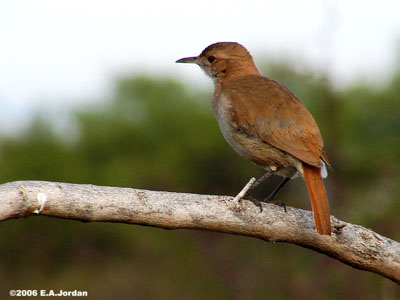
Rufous Hornero – Furnarius rufus
Passeriforme Order - Furnariidae Family
BIOMETRICS: Length : 16-23 cm ; Weight : 31-65 g
DESCRIPTION:
Rufous Hornero is endemic to South America. This bird is the Argentina’s national bird.
It forms a part of the Furnariidae Family, and this species builds particular oven-shaped nest with clay and vegetation, giving the bird its different names.
Its second English name is Red Ovenbird.
Adult male has rufous-brown upperparts, with some pale edges on back and rump. On the upper wing, coverts and secondaries are rufous-brown, whereas primaries are duller, rather brownish. We can see the pale buff bend of the wing. The tail is relatively short. The uppertail coverts are rufous. Tail feathers are darker.
On the underparts, the throat is whitish, turning pale buff on the breast, and paler on belly. Flanks are dark buff. The undertail coverts are buffy-white.
On the head, forehead is rufous-brown, blending into duller brownish crown and nape. We can see an indistinct pale rufous supercilium. Lores and malar areas are light rufous. Ear coverts are darker. Chin and throat are whitish.
The slender, almost straight bill has grey or dark brownish upper mandible, whereas lower mandible is paler with dark tip. Eyes are reddish-brown to cinnamon. Legs and feet are grey, brown or blackish.
Both sexes are similar.
Juvenile has paler underparts.
Rufous Hornero has four subspecies:
Furnarius rufus rufus
F.r. albogularis is smaller. Crown is darker and greyer. Underparts are buffer.
F.r. commersoni is similar to previous, with redder back and paler underparts.
F.r. paraguayae has more rufous forehead and nape.
VOICE: SOUNDS BY XENO-CANTO
Rufous Hornero’s song is a long series of raucous burst of “kweep”, often ending with slower, complaining notes, and usually uttered in duet by the pair.
The call includes sharp “jeet” or “krip”, uttered in series. Both mates communicate by loud metallic notes.
HABITAT:
Rufous Hornero is resident in its range. It frequents pastures and cultivated areas, open habitats with bare soil, second-growth scrub, parks and gardens, and may be found near habitations. It is often seen near water such as rivers, lakes and ponds.
It is mostly seen in lowlands, but it also frequents dry, cultivated valleys, and locally, it can be seen up to 3500 metres of elevation.
RANGE:
Rufous Hornero lives in Bolivia, southern Brazil, Paraguay, Uruguay, northern and centre Argentina.
BEHAVIOUR:
Rufous Hornero feeds mainly on several invertebrates’ species, spiders, and some seeds. The bird forages alone or in pairs. It walks while foraging, searching for invertebrates and seeds on the bare ground or among dead leaves, and it often probes into the mud with its bill.
If many Furnariidae sleep at night in their nests, the Rufous Hornero prefers to sleep among dense vegetation, but near its nest.
During the breeding season, and particularly during the nest construction, the mates of the pair perform some displays. To build such nest, they need two to three months (but sometimes only two weeks), and these displays have an important role and strengthen the pair-bonds.
One of the birds is perched on the nest top with mud in the bill. The bird stands upright with lowered wings and bill pointed upwards, while its mate calls loudly from the nest entrance. These displays, both vocal and visual, and the conspicuous large nest, are also used as advertising displays in territorial behaviour. Intruders are expelled by chasing and fighting, accompanied by loud calls.
The Rufous Hornero is often seen collecting nest materials on the ground.
It is resident in its range, and pair-bonds probably last after breeding season.
FLIGHT:
Rufous Hornero has relatively short, rounded wings, showing its sedentary behaviour, and the lack of aerial foraging. It only flies for moving between two places, and only short distances at a time.
REPRODUCTION:
Breeding season occurs mainly during the austral spring and summer.
Rufous Hornero is known for its wonderful oven-shaped nest. This large spherical nest is made with clay, mud and vegetation such as straw. It is large with 20 to 30 cm in diameter, and 20 to 25 cm high. The walls are about 3 to 5 cm thick. Such structure can weight 3 to 5 kg.
The walls made with mud and plant material or dung, are very hard when dry. It is the typical “adobe” technique. The nest is placed up to 8 metres above the ground, and usually situated on exposed tree branch or any suitable structure, or sometimes on the ground in bare areas.
The structure is divided by a wall which separates the entrance from the nest-chamber. The orientation of the entrance may be variable, and it is often positioned contrary to wind or rainfall direction, but not always. Some nests have two entrances whereas others have only a top entrance.
Despite the work and the energy invested in such nest, the Rufous Hornero, as other Furnariidae species, does not reuse the nest and builds a new structure, often above the old one. We can see two or three globular nests one above the other, placed on exposed branch. These nests are used by several other birds’ species when abandoned.
This kind of nest allows high nesting success with good protection against predators. However, this species is often parasitized by the Shiny Cowbird (Molothrus bonariensis), but usually its eggs are ejected.
Female usually lays 2 to 4 eggs. Incubation lasts about 14 to 18 days, shared by both parents. Chicks are brooded and fed by both adults, which share all the nesting duties.
The young fledge about 23 to 26 days after hatching, and depend on their parents during two or three weeks. They remain within the parental territory for 4 to 9 months more. Young may help in new nest building, but parents attack and chase them away from the construction.
This species can produces two broods per season.
DIET:
Rufous Hornero feeds mainly on insects and spiders, and some seeds. Invertebrates, including earthworms, snails and larvae, are taken from the ground, as the seeds. The chicks are fed mainly with insects such as crickets and insects’ larvae.
PROTECTION/THREATS/STATUS:
Rufous Hornero is common, even abundant in most part of its range in suitable habitat. This species is not threatened at this moment.
Fr : Fournier roux
All : Rosttöpfer
Esp : Hornero Común
Ital : Fornaio rossiccio
Nd : Rosse Ovenvogel
Russe : Рыжий печник
Photographs by Eduardo Andrés Jordan
His website: MIS AVES – AVES DE ARGENTINA
Text by Nicole Bouglouan
Sources:
HANDBOOK OF THE BIRDS OF THE WORLD Vol 8 by Josep del Hoyo-Andrew Elliott-David Christie - Lynx Edicions - ISBN: 8487334504
Arthur Grosset's Birds (Arthur Grosset)

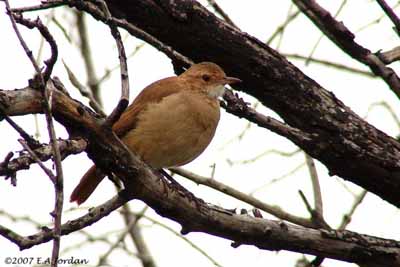
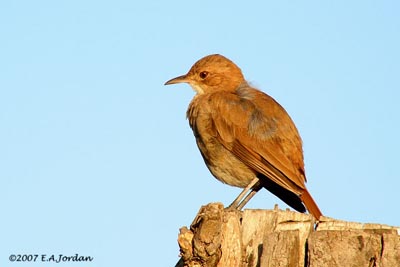
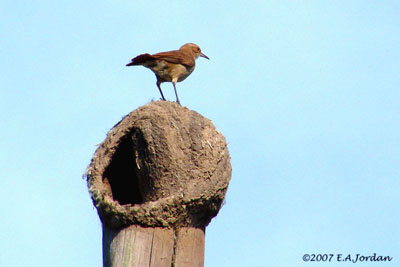
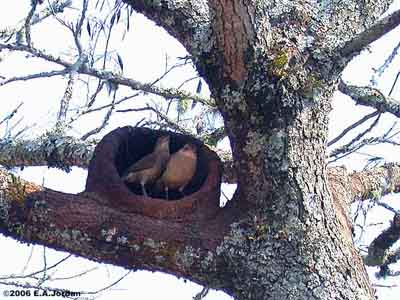
To learn more about the nesting behaviour of Furnariidae species: